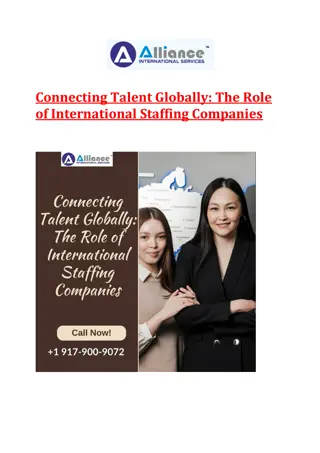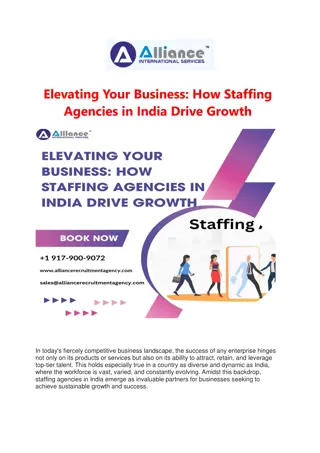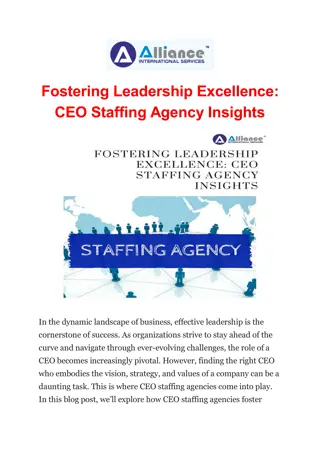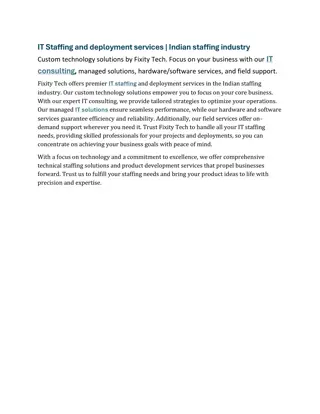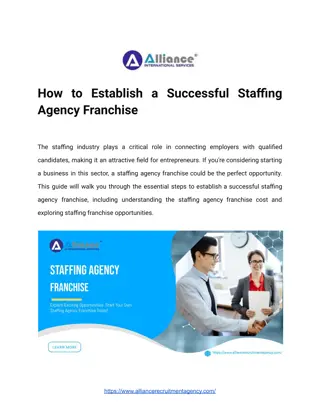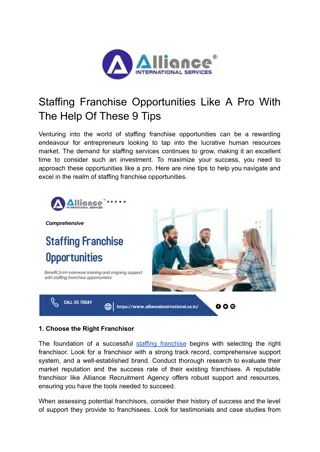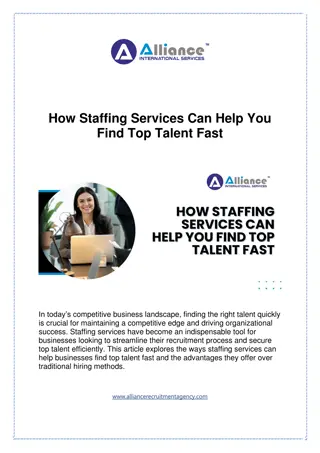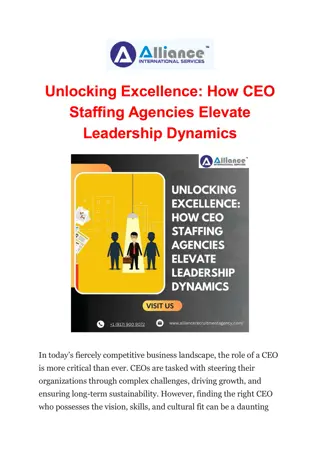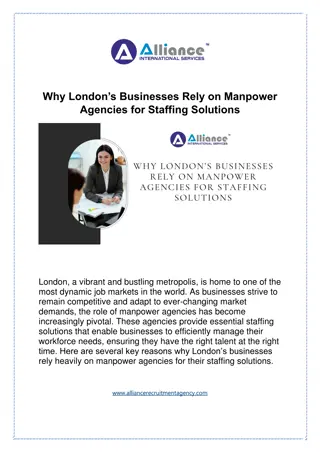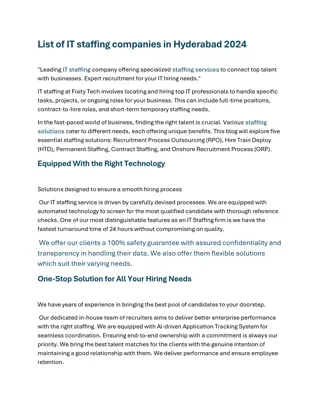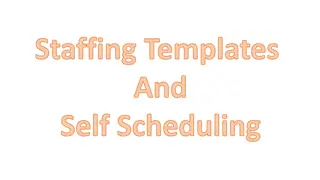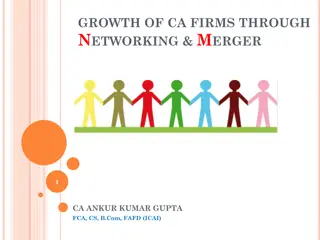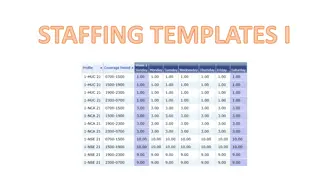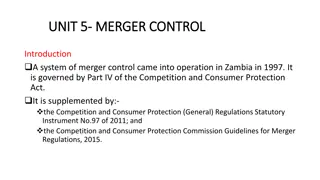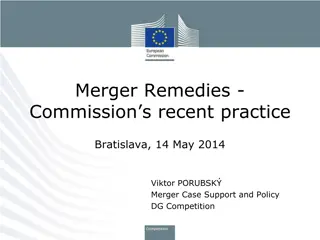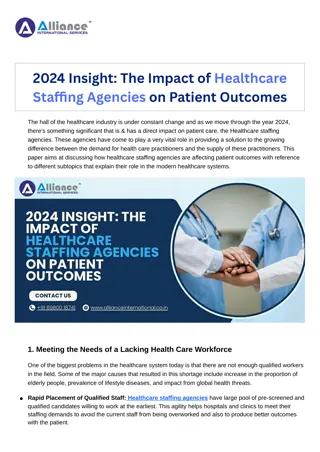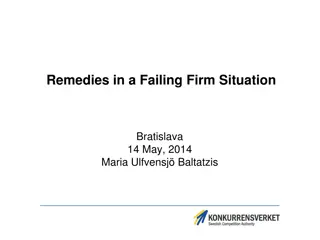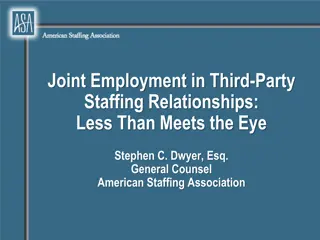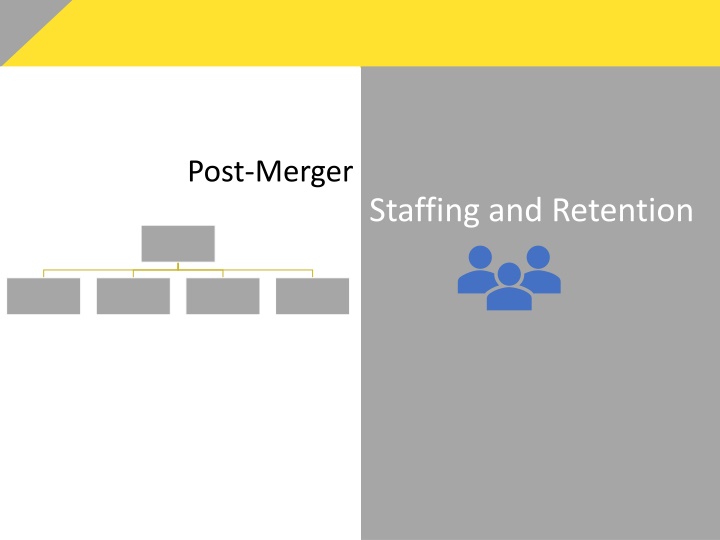
Post-Merger Staffing and Retention Strategies
Explore post-merger staffing and retention strategies to engage and motivate employees through transition periods. Discussions include retention incentives, severance packages, outplacement services, and synergy-linked incentives to support employee morale and productivity.
Download Presentation

Please find below an Image/Link to download the presentation.
The content on the website is provided AS IS for your information and personal use only. It may not be sold, licensed, or shared on other websites without obtaining consent from the author. If you encounter any issues during the download, it is possible that the publisher has removed the file from their server.
You are allowed to download the files provided on this website for personal or commercial use, subject to the condition that they are used lawfully. All files are the property of their respective owners.
The content on the website is provided AS IS for your information and personal use only. It may not be sold, licensed, or shared on other websites without obtaining consent from the author.
E N D
Presentation Transcript
Post-Merger Staffing and Retention 1
Agenda Timing of Timing of Announcement of Job Status to All Employees Announcement of Tier 1 Organization Design and Staffing Decisions Meeting Objectives Timing Dependencies Severance for Acquirer Employees Post -Close Post-Close Outplacement Services Pre-Close Retention Incentives Acquirer Transition Incentives Organization Design ,Staffing, and Retention Interdependencies Post -Close Incentives Linked to Synergies Interview Process Transition Agreements Severance Reductions in Force Staffing Q&A Staffing Deliverables 2 2
Meeting Objectives Discuss how all retention, severance, outplacement, transition and synergy-linked incentives will support the goal of engaging and motivating people to perform and behave appropriately through the transition period A. Retention incentives to retain crucial Acquiree employees long-term (currently in place) B. Severance incentives for Acquiree employees who will lose their jobs as a result of the deal (announced) C. Pre-close retention incentives for Acquirer employees at risk because their future employment is ambiguous D. Severance incentives for Acquirer employees who will lose their jobs as a result of the deal (match Acquiree severance) E. Post-Close outplacement services for any employee (Acquirer or Acquiree) whose job is terminated as a result of the deal F. Transition incentives for select employees who are identified as critical to some time-specific or milestone-complete transitional initiatives/knowledge transfers, but not needed permanently G. Post-Close incentives linked to synergy capture (and how these incentives factor into the overall business incentives for the combined business) 3 3
Meeting Objectives (cont.) Agree on a date when we can provide answers to all employees in the combined organization on their employment status (i.e., Close plus 30, 60, 90 days) Group One: People who have jobs with the combined organization Group Two: People who do not have jobs with the combined organization Group Three: People who are needed temporarily through a specified transition period, but not permanently Work backwards from that date to determine when Tier 1 org. design and staffing decisions must be made to support that decision, respecting the fact that certain hurdles must be cleared (i.e., shareholder vote, regulatory approval, or Close) 4 4
Timing of Announcement of Job Status to all Employees By what date we can reliably promise that people will know if they have a permanent job, a temporary job, or no job? Assume this date is Close + ? (30, 60, 90 days) The outer limit for employee tolerance is 100 days post-Close The longer the period of uncertainty after Close, the more severe the potential negative impact on productivity, synergy capture, and customer service Recommendation: Put a stake in the ground Pick a date and work backwards to see if the other processes can support it Close is probably not realistic Close +30 is aggressive, but possible Close+60 is realistic, but increases retention risks Close+90 is pushing the outer limit of tolerance 5
Timing Dependencies All decisions require tradeoffs. Our job is to evaluate the risks and make recommendations in the best interest of the future state organization, while respecting valid concerns about preserving organizational and management integrity should the organizations need to remain independent The timing for Tier 2 and below org. design and staffing decisions is dependent on the timing of Tier 1 org. design and staffing decisions The Executive Committee (EC) needs to understand this dependency in order to realize the urgency of informing us on how and when Tier 1 org. design and staffing decisions will be made The time from the announcement of Tier 1 org. design and staffing decisions to the time of announcement of job status to the entire combined organization will determine the process used internally for selection and staffing Tier 2 6
Timing of Announcement of Tier 1 Org. Design and Staffing Decisions Assumption: This decision is owned by the current EC Assumption: There is a need to think more carefully about a new Tier 1 organizational structure that optimizes the opportunities for growth, succession planning, span of control, management systems, and communication. Towers Perrin consultants are advising the EC on possible org. structures to meet this need. This new Tier 1 organization structure may require the creation of new positions, new functional org. designs, and different reporting relationships. The IMO (and OD/HR Work Integration Team) needs to coordinate with the EC to create a timeline that synchronizes the Tier 1 org. design and staffing decisions to the Tier 2 org. design and staffing decisions to provide one seamless process for org. design and staffing for the combined organization Recommendation: IMO provides recommendation to EC of date to announce job status to all employees of the combined organization (based on OD/HR work stream analysis) EC commits to date they will announce Tier 1 org. design and staffing decisions OD/HR work stream ensures that process for staffing and selection can be accomplished within the period between announcement of Tier 1 org. design and staffing and announcement of job status to all employees of the combined organization 7
Pre-Close Retention Incentives Acquirer Assumption: The pool of candidates for these targeted retention incentives is small and identifiable. It consists primarily of critical Acquirer talent required to ensure the successful integration. Additional retention incentives may be required for these select Acquirer individuals prior to Close because of the uncertainty they are experiencing regarding long- term job security. Additional incentives may be required to ensure they remain with the organization until their job status can be clarified post-Close. Assumption: In order to determine if additional retention incentives are required for Acquirer employees pre-Close, we need to review all incentives currently in place for these select employees. Doing this analysis will allow us to make retention incentive recommendations that are targeted and cost-effective. Recommendation: Identify select employees where retention is at risk pre-Close (Acquirer Management Team?) Analyze current retention incentives in place for these select employees OD/HR work stream makes recommendations for additional retention incentives as appropriate IMO approves additional retention incentives as required 8
Severance for Acquirer Employees Post-Close Decision required about terms of severance (match Acquiree?) Decision required about timing of announcement (with release of synergy targets or at Close?) Assumption: Due diligence modeling was done based on matching Acquiree severance package assuming a certain level of impact at Acquirer. Currently we have no further intelligence to adjust those assumptions. High-level planning (due from the Integration Teams on Jun. 9-10) may provide some additional insight into anticipated impact based on Future State recommendations Recommendation: Within one week, prepare Acquirer severance package and announcement based on matching Acquiree Discuss timing of announcement with IMO (with synergy targets or at Close?) 9
Post-Close Outplacement Services Assumption: Outplacement services will be provided to all employees (Acquirer and Acquiree) whose jobs are eliminated as a result of the deal Questions: What vendor will be used to provide outplacement services? When would these outplacement services be offered? What criteria will be used to determine the level of outplacement services offered? Job title? Years of service? Do the outplacement services being offered resemble the outplacement services provided in previous reductions in force? What must an employee do to qualify for outplacement services? Sign a release? 10
Transition Incentives Assumption: There is a need to develop transition incentives to motivate employees who are needed temporarily during transition, but not permanently. Assumption: In addition to their current salary and benefits, these select employees would receive a bonus for staying in their job and performing at a certain level through a specified period of time or until completion of certain business milestones. Questions: Who is in the best position to identify these select employees? What kind of analysis needs to be done to determine if transition incentives are required for these select individuals? Who can best design these incentives? 11
Post-Close Incentives Linked to Synergies Concept: Is a good idea to consider designing an incentive to motivate the realization of synergy targets post-Close Questions: What recommendations have been made from EC/Towers Perrin? What are the pros and cons of an incentive like this? What are the next steps with regard to this idea? 12
Org. Design, Staffing, and Retention Interdependencies Staffing Decisions Org. Design and Tier 1Org. (Direct Reports to EC and Functional Structure) All employees know job status Tier 2 Org. Tier 3 Org. Tier 4 Org. BOD and EC Deal Announcement 30 Days 60 Days 90 Days Transition Period Regulatory Approval Shareholder Vote Close Retention, Severance, Acquiree Retention and Severance Announced Synergy-related incentives announced Transition Incentives Outplacement, and Transition Incentives Applied Acquirer Severance And Outplacement Services Announced Acquirer Pre-Close Spot Retention Applied (if required) 13 13
Interview Process The Executive Committee will notify Acquirer Tier 1 of individuals nominated as mission- critical for their function. Acquiree and Acquirer will submit recommendations for mission-critical and transition- critical talent at all tiers. Tier 1 leaders are only required to have an interview with those candidates nominated as mission-critical. If there are additional candidates they are aware of and interested in interviewing, but who do not appear in the recommendations, they will contact the Staffing Team or the IMO to discuss. These interviews will give Tier 1 leaders an opportunity to explore why this candidate was nominated as mission-critical and provide a chance to determine if his/her skills, capabilities, and talents to fit the business needs. Tier 1 must schedule interviews with the appropriate hiring managers to meet with these candidates quickly thereafter to ensure that they are retained appropriately. Once have interviewed a candidate, Tier 1 must submit an email to the Staffing Team notifying them that the interview with the nominee is complete. 14
Transition Agreements In addition to mission-critical talent, both organizations will also identify transition-critical talent. These individuals are considered critical to success during a transition period, but not beyond. The Staffing Team will develop Transition Agreements which you can offer in situations where you need talent temporarily, but not permanently. Individuals who accept Transition Agreements will agree to remain employed and hit specified performance objectives until either a specified date or specified business milestone is achieved. At that point, their employment will terminate and they will receive both their severance (enhanced) and a transition incentive. Transition incentives may vary by job and may include spaced payouts to allow flexibility and renewability of agreements. Individuals who accept Transition Agreements but fail to stay for the entire transition period will be eligible for severance (enhanced) but their transition incentives may be prorated or eliminated entirely. 15
Severance Acquiree and Acquirer will offer very similar enhanced severance packages to all employees whose jobs are eliminated as a direct result of the merger (within 24 months after deal Close). If employees are terminated for cause during this period, they will not receive the enhanced severance package. If an employee is offered an equivalent or better job than they currently hold, and they decline the offer, they will not be eligible for severance. All severance will be paid at the time the employee s job is terminated. 16
Reductions in Force At this time, we are anticipating the first reduction in force will occur no sooner than five business days post-Close. This RIF will include jobs that are obviously redundant where transition services are not required. After that, we hope to design the Transition Agreements so they coincide with major integration milestones being achieved, such as the consolidation of all G&A functions and operations. As these business milestones are achieved and the related Transition Agreements expire, it will create natural reductions in force. Acquirer reserves the right to conduct additional RIFs at any time the business or marketplace requires. 17
Staffing Q&A Q1: Will there be reductions in force (RIFs) on Day 1? A. No. We anticipate the first reduction in force will come no sooner than five business days after Day 1. This will allow us to plan and execute the RIF carefully without conflicting with the external marketing being done on Day 1. This will also allow us to stabilize the other Day 1 changes without the complexity of a simultaneous RIF. Q2: What will the combined organization look like on Day 1? A. Prior to Day 1, the OD/HR work stream will map all Acquiree employees to an Acquirer Day 1 organization and manager so that everyone has a home and manager on Day 1. On Day 1 all Acquiree employees will become Acquirer employees. They will be notified via email what organization they have been mapped to and who their manager is. We will explain that this is the Day 1 organization and reporting structure and inform them that this structure and reporting relationship may change over time. Q3: What will employees do on Day 1? A. On Day 1, all employees will report to work as usual, just as they did the day before. Each person will receive an email telling them where to go for their Day 1 briefing later that day. During this briefing they will hear the announcement that the deal has closed and an explanation of when they will know their job status. Each person will receive a logo item. The tone will be more business-like than celebratory. These briefings will be held for logical clusters of employees(clusters will be based on the type of messaging that will be relevant and appropriate for that specific audience). Q4: When will the first RIF occur and who will be in it? A. We anticipate that the first , and only planned RIF, will occur approximately five business days after Close, and will include obviously redundant employees who are not needed even for a transition period. We anticipate that this RIF will include approximately 100 people. 18
Staffing Q&A Q5: How many RIFs are we anticipating and when will they occur. A. We are currently anticipating the need one planned reduction in force, followed by four reductions that will result from the scheduled expiration of transition agreements. The planned RIF will occur within approximately five days post-Close and will include approximately 200 positions being eliminated. Within 30 days post-Close, everyone in the organization will know if they either have: A job A transition agreement These transition agreements will expire at one of four times: Three months post-Close Six months post-Close Nine months post-Close 12 months post-Close Q6: How will people be selected for permanent jobs in Acquirer? Acquiree will nominate mission-critical individuals for consideration. Those nominated will automatically receive an interview opportunity with the hiring manager for the position under consideration. The hiring manager, after reviewing the data book provided on the candidate, will decide whether to offer the position (in the case of an open position) or interview (in cases where there is an incumbent in the position). The hiring manager will forward his recommendation to a governance body prior to making a job offer or announcement to ensure that the staffing process is being administered appropriately and to ensure that the organization is being staffed with the best talent available for the position. 19
Staffing Q&A Q7: What about employees needed temporarily, during the transition, but not permanently? A. Acquiree will also recommend employees they consider transition-critical who are necessary to ensure a successful integration, but whose jobs are not required permanently. These individuals will be offered a transition agreement that will specify the time period they are required to complete and the incentive they will receive for completing it. Employees who are offered transition agreements, but decline them, will be eligible for severance. Q8: Will this transition incentive be in addition to severance? A. Yes, all employees whose jobs are eliminated as a direct result of the merger within 24 months after Close will be offered severance packages. In addition, those willing to sign a transition agreement will receive the transition incentive upon completion of their transition commitment. Q9: Will there be jobs lost on the Acquirer side of the deal? A. Yes. The staffing process will create situations where an Acquirer employee is the incumbent in a job for which an Acquiree mission-critical employee has been recommended. In such cases the hiring manager must decide the person most qualified for the position and best suited to support Acquirer s business strategy and objectives. Q10: Will the severance packages for Acquirer and Acquiree employees be similar? A. Yes. The two companies have consulted to ensure as equitable a severance package as possible. Both severance packages have been enhanced above either company s standard severance packages to acknowledge that people are being released as a result of redundancies created by the merger, and not for performance-related reasons. 20
Staffing Q&A Q11: If I m not recommended by Acquiree as being mission-critical or transition-critical, does that automatically mean I can t get a job with Acquirer? A. Not necessarily. There may be open positions created through natural attrition or that require skill sets outside those recommended as mission-critical by Acquiree. Those positions will be posted and Acquiree applicants will be given consideration prior to external candidates. Q12: If I m recommended by Acquiree as mission-critical, and I interview for a position equivalent to my current position, but do not receive a job offer, can I still receive severance? A. Yes. Those candidates considered, but not offered permanent jobs will either be considered for transition-critical roles (with severance paid at expiration of their agreement) or they will receive severance when their job is eliminated. Q13: Why did Acquirer select this staffing approach? A. The objective of this staffing approach is to ensure that Acquirer is rapidly staffed for growth and high-performance while minimizing disruption to customers and distraction to the core business. This staffing approach is the most efficient way to ensure that the mission-critical talent from Acquiree is considered for employment with Acquirer. This approach also takes into consideration the need to retain transition-critical employees to ensure a seamless integration. It also provides all employees with answers to their job status questions as quickly as possible. Acquirer is committed to treating all employees from both companies with dignity and respect as we go through this difficult process of deciding the talent required to ensure Acquirer s future success. 21
Staffing Deliverables Tier 0 org. structure and staffing (Executive Committee) Tier 1 org. structure and staffing (Direct reports to Executive Committee) Tier 2 org. structure and staffing (Direct reports to Tier 1) Functional org. charts for the remainder of the organization Criteria for recommendations of mission-critical and transition-critical Acquirer employees Slotting/Interviewing processes, tools, and training for selecting Tiers 3-n (assume 6 tiers) Governance to ensure process is administered properly and adhered to rigorously Organizational mapping to clarify Day 1 functional groups and managers Severance policy Outplacement services Transition agreements/ Transition incentives Other retention incentives Offer letters Legal reviews (WARN Act, Adverse Impact Review) Communications to support all of the above 22

